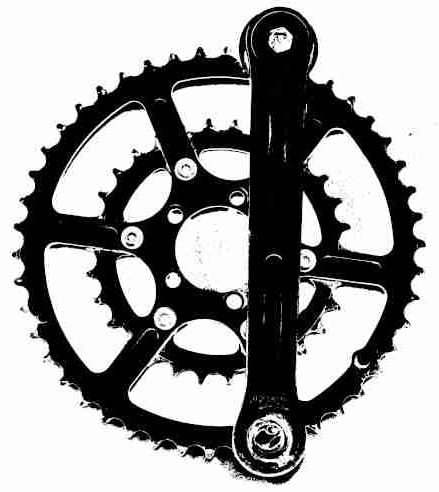Which Rim Tape Width?
There is lots of confusion on the proper rim tape width for different sets of bicycle wheels. I wrote this article to give you a few simple rules to follow.
Rim tape sizing principles are actually fairly simple: non-adhesive hard tapes should cover the rim bed flank-to-flank, while adhesive tapes should just cover the spoke holes or nipples with some margin on either side. The challenge lies in estimating how much tape width it actually takes to cover the rim bed, given that the tape follows the curved shape of the bed.
Next we will break rim tape dimensioning into three cases: non-adhesive tape, adhesive tape and “tubeless” adhesive tape. We end with a quick note on the tape types.
Rim tape width – Non-adhesive
With non-adhesive rim tape, pick a tape that just covers all of the rim bed width. You can undershoot by a few mm, but do not overshoot.
| NON-ADHESIVE RIM TAPE Rim width*->Tape width** | Rim width->Tape width |
|---|---|
| 13/14mm -> 16…22mm | 25/26mm -> 28…34mm |
| 15/16mm -> 18…24mm | 27/28mm -> 30…36mm |
| 17/18mm -> 20…26mm | 29/30mm -> 32…38mm |
| 19/20mm -> 22…28mm | 31/32mm -> 34…40mm |
| 21/22mm- > 24…30mm | 33/34mm -> 36…42mm |
| 23/24mm -> 26…32mm | 35/36mm -> 38…44mm |
| *rim width is internal (gap) width | **lower end for small drop-center/ hookless rims |
Note that you usually need a tape 2…10 mm wider than the rim internal width to cover the rim bed. This is because in the common clincher-type rim, the ‘rim width/internal width’ is measured between the bead hooks (i.e. the narrowest spot) and most rims have a center recess of some sort, which takes up extra tape width.
How much extra you need depends on the rim type. A flexible tape measure gives you the most accurate rim bed width (press it to the contour), but you can also use the following rules:
- Clincher rims with a substantial recess in the center: select a non-adhesive tape 5…8 mm wider than the rim internal width. Tape width = rim internal width + 5…8 mm
- Clincher rims with a modest recess in the center: select a non-adhesive tape 2…5 mm wider than the rim internal width. Tape width = rim internal width + 2…5 mm
For your convenience, I tabulated the values out of these rules into the table above.
(Term note: Clincher or Crotchet, ‘hooked’, rims are the most common rim type. Unless you have a steel rim, a very old rim (<1980s), or a very recent specialty, low-pressure road or MTB bike rim, your rim is probably a clincher.)
Rim tape width – Adhesive
With an adhesive-backed rim tape, pick a tape width that covers the spoke holes or the nipple heads with at least 3 mm (1/8″) margin on either side.
An adhesive rim tape stays in place, so there is no need to cover all of the rim bed as with non-adhesive tapes. That said, covering the whole bed is still OK.
Common traditional adhesive-backed textile rim tape widths are 15 mm, 16 mm and 18 mm. This selection is usually enough to cover different spoke hole sizes.
With rims that have a drop-center in the middle of the rim bed, it is often convenient to select the adhesive rim tape width to match the drop-center width. However, you should still make sure the tape covers the spoke holes with enough margin.
| ADHESIVE RIM TAPE WIDTH Rim width* | Tape width |
|---|---|
| 13…14mm | 18 mm |
| 15…16mm | 18 mm |
| 17mm and wider | 15 or 18 mm (fit to cover holes) |
| *rim width is internal (gap) width |
Rim tape width – Tubeless
For a tubeless tire setup, select a tubeless-ready adhesive rim tape that covers the entire rim bed width.
Rim tape for tubeless tire setups, often called “tubeless-ready rim tape” or simply “tubeless tape”, is a sub-type of adhesive rim tape. Air-tightness requires this tape to be much wider than an adhesive tape otherwise would be.
Note that you will need a tape wider than the internal width of the rim – just as with non-adhesive tapes on a conventional tire setup (see above). Again, you can measure the rim bed width (along surface) with a flexible tape measure or a piece of paper.
Which type of rim tape should I use?
Double-walled rims: Pick either a non-adhesive hard plastic tape (e.g. Schwalbe High Pressure) or an adhesive-backed textile tape. Do not use rubber tapes or rim tape substitutes – these cannot be guaranteed to carry the tube pressure over the rim holes.
Single-walled rims: Pick any type of rim tape, as long as it is wide enough (see above).
Tubeless setup: Use a “tubeless-ready” adhesive rim tape.
Can rim tape be too wide?
Yes – a rim tape can be too wide for a rim. The rule is that the tape should not rise to the rim flanks. This would lower the effectiveness of the bead hook, increasing the risk of a tire slipping off the rim.
Can you use electric tape as rim tape?
Electric tape can be used as rim tape with older single-walled rims. I recommend using at least two layers to ensure that sharp nipple edges.
Electric tape should not be used with double-walled rims. These rims have large spoke holes where the tape must carry the tube pressure over a large area – electric tape cannot be trusted to do this.


